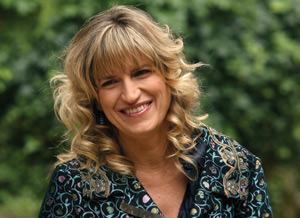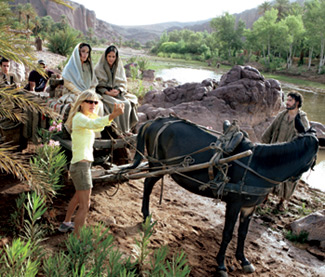BY MARGY ROCHLIN
 (Photo Credit: Elisabetta Villa/Getty Images)
(Photo Credit: Elisabetta Villa/Getty Images)In 2003, a raw, R-rated independent film about the scary decline of a pair of teenage girls changed the perception of Catherine Hardwicke from sought-after production designer (Three Kings, Tombstone) to an award-winning director who, if necessary, could will a project into being. Part of the much-repeated legend of Thirteen is that in a six-day creative burst, Hardwicke co-wrote the script for her directorial debut with Nikki Reed, a 13 year old in the midst of a wildly rebellious stage and in dire need of refocusing. What is rarely mentioned is that Thirteen was Hardwicke's third attempt at getting a studio to finance one of her original scripts and allow her to direct it.
According to Hardwicke, her two earlier screenplays—a Civil War drama called Soldier Girl and the all-female survival thriller Bulldog Dance—came with too high a price tag for a studio to risk on an untested director. On the other hand, Thirteen was a project that Hardwicke mapped out so that even if no one gave her money, she could shoot it with a home video camera at borrowed locations and use the contents of her own closet as wardrobe. Her approach, says Hardwicke, is the adult equivalent of "Nothing Can Stop Me," a game she's been playing since she was a 5 year old growing up in small-town McAllen, Texas. "You'd start at one end of your house," says Hardwicke, standing up in her high-ceilinged office located behind her Venice beach bungalow, raising her arms and intoning in a robotic voice "Nothing can stop me," as she bounces off tables, chairs and a reporter to show how she'd get to her destination.
After she finally pulled together $1.5 million in backing, she had to complete Thirteen in 17 days with a primarily teenage cast who weren't just difficult to keep focused but legally could work no more than eight hours a day. Hardwicke rattles off the problems she faced: "The radically short schedule, working with underage actors, and harnessing the energy on the set to actually make the scenes happen against all rules of chaos that exist in the universe. How do you keep on with it? Noth-ing can stop me."
Hardwicke adds that the compressed schedule of Thirteen taught her that when daylight began to wane, rely on "moving masters" or scenes shot with no coverage. "In the worst-case scenario, I'd go into desperate desperado mode. If I only had one take, I'd try to make it dynamic, make it move and change composition. If you look at Thirteen, you'll see lots that was [done in] one shot."
Hardwicke's persistence paid off when she won a directing award for the film at the 2003 Sundance Film Festival. Since then, she has made two other films—the scruffy rise-of-skateboarding docudrama Lords of Dogtown and The Nativity Story, a rendering of Jesus' birth which positioned the Virgin Mary, as many historians now do, as an apprehensive 14 year old. If part of what links her oeuvre is her sympathetic, life-sized take on the roiling upheavals of adolescence, another through line is the full-force, obstacle-clearing approach that Hardwicke applies to moviemaking. While still in the project-shopping stage, she applies the graphic arts skills she picked up as an architecture major at University of Texas in Austin and bombards execs with visual aids: slickly designed faux movie posters that display innumerable marketing angles, or spiral-bound laminated flip books that Hardwicke has filled with photographs—images torn from magazines with captions that convey everything from color palette to the film's stirring emotional themes.
 Animal House: Directing The Nativity Story, Hardwicke learned that donkeys
Animal House: Directing The Nativity Story, Hardwicke learned that donkeys
are easiest to direct. (Credit: Jamie Trueblood/Newline.wireimage.com)"It's about trying to push the rock up the hill, trying to get somebody excited about the damn thing," says Hardwicke, who also likes to shoot actors improvising from the script, edit the footage, add music and then show it to the potential studio so they can see what she is aiming for. While all this brings Hardwicke one step closer to a go-picture, it's also an opportunity for her to see if cast members click. "I bring them here to my house because it's a lot funkier, and we can run around the beach and get crazier as opposed to being in a more sterile casting office," says Hardwicke, who can still remember gazing through her video camera's viewfinder at Thirteen co-stars Nikki Reed and Evan Rachel Wood jumping up and down on her bed, realizing the authenticity of the two young actresses' interaction. "It was just magic. You could just see this was going to kill."
When Hardwicke finally gets her yes, the impromptu videotaping ends and—just before production commences—"boot camp" begins. In this one- to three- week immersion process, Hardwicke creates a variety of ways to help her actors get into character. For Thirteen, she had Nikki Reed, Evan Rachel Wood and Holly Hunter, who plays Woods' fragile, recovering alcoholic mother, spend nights in the same tattered ranch house where they would soon be filming scenes. The cast for The Nativity Story was trained in goat milking and seed sowing, all the while dressed in period-appropriate tunics and sandals so they could get used to how it felt to move around in biblical garb. "How else could I get a modern girl to put down her cellphone and go back 2,000 years where you're working every minute, connected to the land?" she asks.
Hardwicke traces her love of meticulously observed authenticity to having the motto "God is in the details" drummed into her during her architecture-school days. "If Holly Hunter is supposed to be a poor hairdresser and she's in Gucci, it's not going to feel like she lives in that house," Hardwicke explains, adding that it creates an unconscious boost to the cast as well. "I feel that level of detail makes a lot of difference to the actor. They feel it and they live it."
It was in the early '80s, after seeing Raiders of the Lost Ark, when it occurred to Hardwicke that "somebody got to build some interesting things!" Soon, she'd left the world of building design and was enrolled at UCLA film school. Though directing was always her plan, on her way up she occupied nearly every job in showbiz, from gun wrangler to stuntwoman. Her architecture degree was her only credential on her first job as a production designer for a low-budget skateboard movie called Thrashin'.
Five years later when she switched to directing and was hiring a production designer, she asked the applicants, "Can you handle someone like me who has done your job before?" She was worried that she'd be too demanding. But she immediately found there was an upside to the collaboration. "In some ways, they have it easy. Some directors I worked with didn't even know how to read a blueprint, understand a plan. I can cut to the chase. I can do a one-second drawing and say, 'Nazareth village is here and there's a main street down there,' and they can come back with a detailed sketch or rendering."
Since directing Thirteen, each production has revealed its own set of lessons, its own textbook in how to avoid the pitfalls for the next project. From The Nativity Story, for example, she discovered that out of all of God's creatures, donkeys are the easiest to direct and "sheep are just psychotic."
Just today, Hardwicke has been given the go-ahead on a new thriller-romance called Twilight, based on Stephenie Meyer's young-adult vampire novel of the same name. She's been thinking about how to make the Twilight shoot as easy as possible. "I'm trying to cut all the dogs out of the script, and it has a deer, but I think I'm going to give them to second unit," says Hardwicke, with a laugh. "I'm kind of kidding, but kind of not. Animals are very difficult."